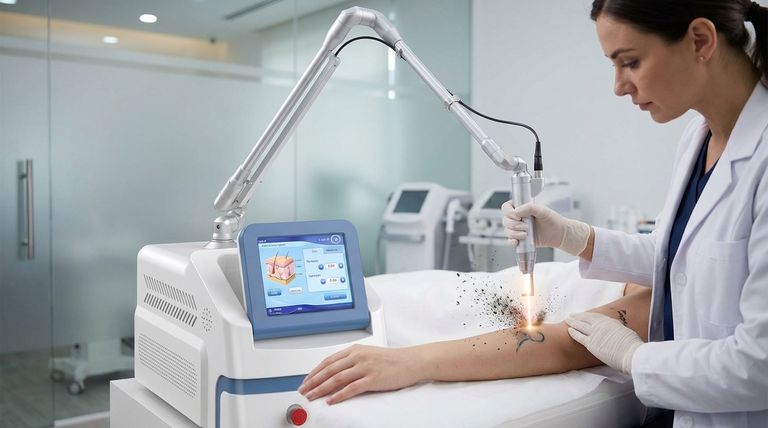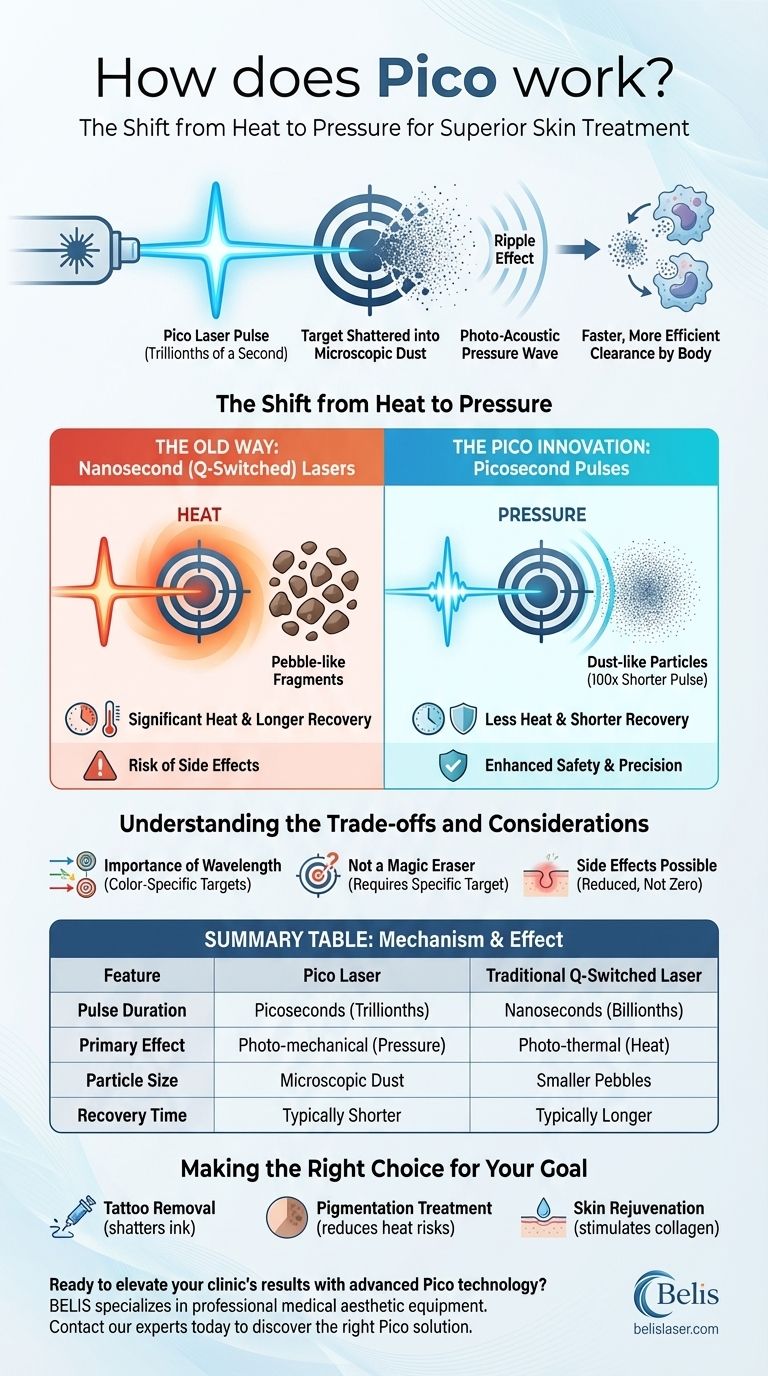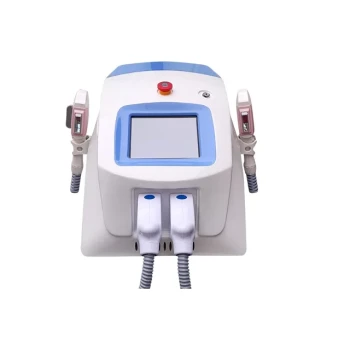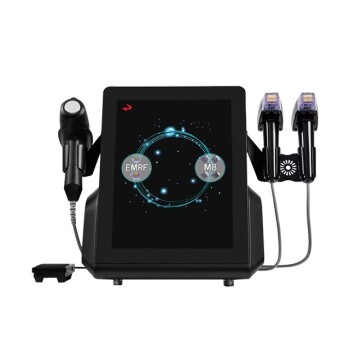At its core, a Pico laser works by delivering unimaginably fast and powerful pulses of light energy into the skin. These pulses are so short—measured in picoseconds (trillionths of a second)—that they don't burn the skin with heat. Instead, they create a powerful pressure wave that shatters the target, such as tattoo ink or excess pigment, into microscopic dust-like particles that the body can then easily eliminate.
The fundamental innovation of the Pico laser is its speed. By replacing the slow, thermal (heat) effect of older lasers with a rapid, photo-mechanical (pressure) impact, it shatters skin targets more effectively while minimizing damage to the surrounding tissue.

The Shift from Heat to Pressure
To understand what makes Pico technology a significant advancement, it's essential to compare it to the previous generation of lasers used for similar purposes.
The Old Way: Nanosecond (Q-Switched) Lasers
Older lasers, known as Q-switched or nanosecond lasers, operate on a slightly slower timescale. Their pulses, while fast, are long enough to generate significant heat in the skin.
This photothermal effect essentially "cooks" the pigment or ink, breaking it down into smaller, pebble-like fragments. While effective, this collateral heat increases the risk of side effects and can require longer recovery periods.
The Pico Innovation: Picosecond Pulses
A picosecond is 100 times shorter than a nanosecond. By delivering energy on this incredibly short timescale, the Pico laser doesn't give the skin's chromophores (the parts that absorb light) time to convert the light energy into heat.
The Photo-Acoustic Effect
Instead of heat, the intense, ultra-short energy pulse creates a powerful photo-acoustic wave—a shockwave of pressure.
This pressure wave ripples through the skin and violently shakes the target pigment or ink particle, causing it to shatter. Think of it like an opera singer shattering a crystal glass with a specific sound frequency; the Pico laser shatters its target with a specific light frequency and pressure.
More Efficient Clearance
This mechanical shattering pulverizes the target into particles that are much finer than those produced by older, heat-based lasers.
These tiny "dust" particles are far easier for the body's immune cells (macrophages) to engulf and carry away through the lymphatic system. This can lead to faster clearance, often requiring fewer treatment sessions for the same result.
Understanding the Trade-offs and Considerations
While highly effective, the mechanism of a Pico laser is not a one-size-fits-all solution. Its effectiveness is rooted in precision.
The Importance of the Wavelength
Pico lasers come in different wavelengths (colors of light). The choice of wavelength is critical, as different colors are absorbed by different targets. For example, one wavelength is highly effective for black tattoo ink, while another is needed to target green or blue ink.
It Is Not a Magic Eraser
The laser's effect is entirely dependent on having a specific target—like tattoo ink or melanin (the pigment in age spots)—that will absorb the laser's energy. It does not work on issues that do not have a distinct color target for the laser to "see."
Side Effects Are Possible
The "no heat" mechanism dramatically reduces but does not eliminate side effects. After treatment, patients can still experience temporary redness, swelling, and pinpoint bleeding. While the risk of pigmentary changes (darkening or lightening of the skin) is lower than with thermal lasers, it is not zero.
Making the Right Choice for Your Goal
Understanding this mechanism helps you determine if a Pico laser is the optimal tool for your specific skin concern.
- If your primary focus is removing a stubborn or multi-colored tattoo: Pico's photo-acoustic effect offers a distinct advantage in shattering ink more efficiently than older heat-based lasers.
- If your primary focus is treating pigmentation like melasma or sun spots: The lower heat and targeted nature of Pico lasers reduce the risk of post-inflammatory hyperpigmentation, a key concern with heat-based treatments.
- If your primary focus is skin rejuvenation or acne scarring: The pressure wave can also stimulate new collagen growth deep within the skin, improving texture and scars with minimal damage to the surface and less downtime.
By focusing on mechanical force rather than thermal heat, Pico technology provides a more precise and often safer way to address specific targets within the skin.
Summary Table:
| Mechanism | Pico Laser | Traditional Q-Switched Laser |
|---|---|---|
| Pulse Duration | Picoseconds (trillionths of a second) | Nanoseconds (billionths of a second) |
| Primary Effect | Photo-mechanical (Pressure Wave) | Photo-thermal (Heat) |
| Particle Size | Microscopic Dust | Smaller Pebbles |
| Recovery Time | Typically Shorter | Typically Longer |
Ready to elevate your clinic's results with advanced Pico technology?
BELIS specializes in professional medical aesthetic equipment, providing clinics and premium beauty salons with the latest Pico laser systems. Our technology delivers superior outcomes for tattoo removal, pigmentation, and skin rejuvenation with enhanced safety and efficiency.
Contact our experts today to discover the right Pico solution for your practice and client needs.
Visual Guide

Related Products
- Pico Picosecond Laser Machine for Tattoo Removal Picosure Pico Laser
- Clinic Use IPL and SHR Hair Removal Machine with Nd Yag Laser Tattoo Removal
- Clinic Use IPL SHR ND YAG Laser Hair Removal RF Skin Tightening Machine
- Diode Laser SHR Trilaser Hair Removal Machine for Clinic Use
- Trilaser Diode Hair Removal Machine for Beauty Clinic Use
People Also Ask
- How much does it cost to do pico laser? A Clear Breakdown of Pricing Factors
- What is pico fractional laser good for? Rebuild Your Skin from Within
- What is the disadvantage of Pico laser treatment? Understand the Risks and Costs Before You Decide
- What are the downsides of Pico laser? Understanding the Risks for Safe Treatment
- How many sessions of Pico laser do you need to see results? A Realistic Timeline for Your Skin Goals



















